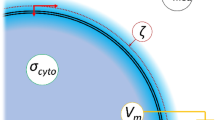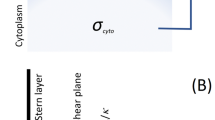Summary
A divalent anionic dye, bis-[3-methyl-1-p-sulfophenyl-5-pyrazolone-(4)]-pentamethine oxonol (WW 781) is a rapidly responding fluorescent indicator of KCl diffusion potentials induced in human red blood cells with valinomycin, gramicidin, and with the Ca ionophore A 23187 in the presence of external Ca. WW 781 has a sensitivity of 0.13% ΔF/mV, a detection limit of 10 mV, a response time of less than 1 sec, and exhibits a decrease in fluorescence intensity upon hyperpolarization without detectable shifts in absorption or emission peaks. This dye does not perturb the normal resting potential, and unlike the slow permeant cyanine dyes, does not inhibit Ca-induced K conductance in human red blood cells. However, WW 781 does stimulate Ca-induced unidirectional Rb efflux. With Ca plus A 23187, the initial rapid change in dye fluorescence is sensitive to [Ca] o and to [A 23187], is reversible with excess EGTA, and is inhibited by quinine, oligomycin, and by trifluoperazine. A biphasic dependence of hyperpolarization on K o is evident at pH 6, where the ionic selectivity of activation is K, Rb>Cs>Na and that of conductance is K, Rb>Cs. Conditions were defined which permitted continuous monitoring ofE m for at least 10 min, and the time dependence of the Ca-induced potentials was characterized. Since the properties of the Ca-induced changes in dye fluorescence correlate well with the known characteristics of Ca-induced K permeability, we conclude that WW 781 is a useful indicator of changes inE m, provided that sufficient controls are employed to separate direct effects of Ca on dye fluorescence from the effects ofE m on fluorescence.
Similar content being viewed by others
References
Armando-Hardy, M., Ellory, J.C., Ferreira, H.G., Fleminger, S., Lew, V.L. 1975. Inhibition of the calcium-induced increase in the potassium permeability of human red blood cells by quinine.J. Physiol. (London) 250:32P-33P
Baylor, S.M., Chandler, W.K., Marshall, M.W. 1981. Studies in skeletal muscle using optical probes of membrane potential.In: The Regulation of Muscle Contraction: Excitation-Contraction Coupling. A. Grinnell, editor. pp. 97–127. Academic Press, New York
Beeler, T.J., Farmen, R.H., Martonosi, A.N. 1981. The mechanism of voltage-sensitive dye responses on sarcoplasmic reticulum.J. Membrane Biol. 62:113–137
Blum, R.M., Hoffman, J.F. 1971. The membrane locus of Ca-stimulated K transport in energy depleted human red blood cells.J. Membrane Biol. 6:315–328
Blum, R.M., Hoffman, J.F. 1972. Ca-induced K transport in human red cells: Localization of the Ca-sensitive site to the inside of the membrane.Biochem. Biophys. Res. Commun. 46:1146–1152
Cohen, L.B., Hoffman, J.F. 1982. Optical measurements of membrane potential.In: Techniques in Cellular Physiology. P 118:1–13. Elsevier/North Holland
Cohen, L.B., Kamino, K., Lesher, S., Wang, C.H., Waggoner, A.S., Grinvald, A. 1977. Possible improvements in optical methods for monitoring membrane potential.Biol. Bull. (Woods Hole, Mass.) 153:419
Cohen, L.B., Salzberg, B.M. 1978. Optical measurement of membrane potential.Rev. Physiol. Biochem. Pharmacol. 83:35–88
Dillon, S., Morad, M. 1981. A new laser scanning system for measuring action potential propagation in the heart.Science 214:453–456
Dodge, J.T., Mitchell, C., Hanahan, D.J. 1963. The preparation and chemical characteristics of hemoglobin-free ghosts of human erythrocytes.Arch. Biochem. Biophys. 100:119–130
Ekman, A., Manninen, V., Salminen, S. 1969. Ion movements in red cells treated with propranolol.Acta Physiol. Scand. 75:333–344
Freedman, J.C. 1980. Oxonol 781 fluorescence responds to membrane potentials in the Gardos effect of human red blood cells.Fed. Proc. 39:2130
Freedman, J.C., Hoffman, J.F. 1979a. Ionic and osmotic equilibria of human red blood cells treated with nystatin.J. Gen. Physiol. 74:157–185
Freedman, J.C., Hoffman, J.F. 1979b. The relation between dicarbocyanine dye fluorescence and the membrane potential of human red blood cells set at varying Donnan equilibria.J. Gen. Physiol. 74:187–212
Freedman, J.C., Hoffman, J.F. 1979c. Properties of a fast fluorescent dye for membrane potentials in human red blood cells.Biophys. J. 25:302a
Freedman, J.C., Laris, P.C. 1981. Electrophysiology of cells and organelles: Studies with optical potentiometric indicators.Int. Rev. Cytol., Supp. 12. pp. 177–246
Freedman, J.C., Novak, T.S. 1981. Characteristics of voltages associated with Ca-induced K conductance in human red blood cells, as studied by means of a fluorescent oxonol dye, WW 781.Biophys. J. 33:3a
Gardos, G. 1959. The role of calcium in the potassium permeability of human erythrocytes.Acta Physiol. Acad. Sci. Hung. 15:121–125
Gardos, G., Szasz, I., Sarkadi, B. 1977. Effect of intracellular calcium on the cation transport processes in human red cells.Acta Biol. Med. Ger. 36:823–829
Glynn, I.M., Warner, A.E. 1972. Nature of the calcium dependent potassium leak induced by (+)-propranolol, and its possible relevance to the drug's antiarrhythmic effect.Br. J. Pharmacol. 44:271–278
Goldinger, J.M., Hoffman, J.F. 1976. Mechanism of propranolol induced Ca-dependent K efflux from human red blood cells.Fed. Proc. 35:834
Gupta, R.K., Salzberg, B.M., Grinvald, A., Cohen, L.B., Kamino, K., Lesher, S., Boyle, M.B., Waggoner, A.S., Wang, C.H. 1981. Improvements in optical methods for measuring rapid changes in membrane potential.J. Membrane Biol. 58:1–15
Heinz, A., Passow, H. 1980. Role of external potassium in the calcium-induced potassium efflux from human red blood cell ghosts.J. Membrane Biol. 57:119–131
Heytler, P.G., Prichard, W.W. 1962. A new class of uncoupling agents — carbonyl cyanide phenylhydrazones.Biochem. Biophys. Res. Commun. 7:272–275
Hladky, S.B., Rink, T.J. 1976. Potential difference and the distribution of ions across the human red blood cell membrane: A study of the mechanism by which the fluorescent cation, diS-C3 (5) reports membrane potential.J. Physiol. (London) 263:287–319
Hoffman, J.F., Blum, R.M. 1977. On the nature of the pathway used for Ca-dependent K movement in human red blood cells.Adv. Exp. Med. Biol. 84:381–405
Hoffman, J.F., Knauf, P.A. 1973. The mechanism of the increased K transport induced by Ca in human red blood cells.In: Erythrocytes, Thrombocytes, Leukocytes. E. Gerlach, K. Moser, E. Deutsch and W. Wilmans, editors. pp. 66–70. G. Thieme, Publishers, Stuttgart
Hoffman, J.F., Laris, P.C. 1974. Determinations of membrane potentials in human andAmphiuma red blood cells by means of a fluorescent probe.J. Physiol. (London) 239:519–552
Hoffman, J.F., Tosteson, D.C., Whittam, R. 1960. Retention of potassium by human erythrocyte ghosts.Nature (London) 185:186–187
Hoffman, J.F., Yingst, D.R., Goldinger, J.M., Blum, R.M., Knauf, P.A. 1980. On the mechanism of Ca-dependent K transport in human red blood cells.In: Membrane Transport in Erythrocytes. Alfred Benzon Symposium 14. U.V. Lassen, H.H. Ussing and J.O. Wieth, editors. pp. 178–192. Munksgaard, Copenhagen
Hunter, M.J. 1977. Human erythrocyte anion permeabilities measured under conditions of net charge transfer.J. Physiol. (London) 268:35–49
Knauf, P.A., Fuhrman, G.F., Rothstein, S., Rothstein, A. 1977. The relationship between anion exchange and net anion flow across the human red blood cell membrane.J. Gen. Physiol. 69:363–386
Knauf, P.A., Riordan, J.R., Schuhman, B., Wood-Guth, I., Passow, H. 1975. Calcium-potassium-stimulated net potassium efflux from human erythrocyte ghosts.J. Membrane Biol. 25:1–22
Kregenow, F.M., Hoffman, J.F. 1972. Some kinetic and metabolic characteristics of calcium-induced potassium transport in human red cells.J. Gen. Physiol. 60:406–429
Lassen, U.V., Pape, L., Vestergaard-Bogind, B. 1976. Effect of calcium on the membrane potential ofAmphiuma red cells.J. Membrane Biol. 26:51–70
Lassen, U.V., Pape, L., Vestergaard-Bogind, B. 1980. Calcium related transient changes in membrane potential of red cells. Experimental observations and a model involving calcium-dependent regulator (CDR).In: Membrane Transport in Erythrocytes. Alfred Benzon Symposium 14. U.V. Lassen, H.H. Ussing and J.O. Wieth, editors. pp. 256–273. Munksgaard, Copenhagen
Lepke, S., Passow, H. 1972. The effect of pH at hemolysis on the reconstitution of low cation permeability in human erythrocyte ghosts.Biochim. Biophys. Acta 255:696–702
Lew, V.L., Ferreira, H.G. 1976. Variable Ca sensitivity of a K-selective channel in intact red cell membranes.Nature (London) 263:336–338
Lew, V.L., Ferreira, H.G. 1977. The effect of Ca on the K permeability of red cells.In: Membrane Transport in Red Cells. J.C. Ellory and V.L. Lew, editors. pp. 93–100. Academic Press, New York
Lew, V.L., Ferreira, H.G. 1978. Calcium transport and the properties of a calcium-activated potassium channel in red cell membranes.Curr. Top. Membr. Transp. 10:217–277
Liu, C., Hermann, T.E. 1976. Characterization of ionomycin as a calcium ionophore.J. Biol. Chem. 253:5892–5894
Macey, R.I., Adorante, J.S., Orme, F.W. 1978. Erythrocyte membrane potentials determined by hydrogen ion distribution.Biochim. Biophys. Acta 512:284–295
Motais, R. 1977. Organic anion transport in red blood cells.In: Membrane Transport in Red Cells. J.C. Ellory and V.L. Lew, editors. pp. 197–220. Academic Press, New York
Myers, V.B., Haydon, D.A. 1972. Ion transfer across lipid membranes in the presence of Gramicidin A. II. The ion selectivity.Biochim. Biophys. Acta 274:313–322
Passow, H. 1963. Metabolic control of the passive permeability for potassium ions.In: Cell Interface Reactions. A.D. McLaren, P. Mitchell and H. Passow, editors. pp. 57–101. Scholar's Library, New York
Passow, H. 1981. Selective enhancement of potassium efflux from red blood cells by lead. A comparison with the effects of calcium.In: The Function of Red Blood Cells: Erythrocyte Pathobiology. D.F.H. Wallach, editor. pp. 79–101. Alan R. Liss, New York
Raaflaub, J. 1956. Applications of metal buffers and metal indicators in biochemistry.Methods Biochem. Anal. 3:301–325
Reed, P.W. 1976. Effects of the divalent cation ionophore A 23187 on potassium permeability of rat erythrocytes.J. Biol. Chem. 251:3489–3494
Reichstein, E., Rothstein, A. 1981. Effects of quinine on Ca++-induced K+ efflux from human red blood cells.J. Membrane Biol. 59:57–63
Riordan, J.R., Passow, H. 1971. Effects of calcium and lead on potassium permeability of human erythrocyte ghosts.Biochim. Biophys. Acta 249:601–605
Sarkadi, B., Szasz, I., Gardos, G. 1976. The use of ionophores for rapid loading of human red cells with radioactive cations for cation-pump studies.J. Membrane Biol. 26:357–370
Simons, T.J.B. 1976a. Carbocyanine dyes inhibit Ca-dependent K efflux from human red cell ghosts.Nature (London) 264:467–469
Simons, T.J.B. 1976b. The preparation of human red cell ghosts containing calcium buffers.J. Physiol. (London) 256:209–225
Simons, T.J.B. 1976c. Calcium-dependent potassium exchange in human red cell ghosts.J. Physiol. (London) 256:227–244
Simons, T.J.B. 1979. Actions of a carbocyanine dye on calcium-dependent potassium transport in human red cell ghosts.J. Physiol. (London) 288:481–507
Sims, P.J., Waggoner, A.S., Wang, C., Hoffman, J.F. 1974. Studies on the mechanism by which cyanine dyes measure membrane potential in red blood cells and phosphatidyl choline vesicles.Biochemistry 13:3315–3330
Steck, T.L. 1974. Preparation of impermeable inside-out and right-side-out vesicles from erythrocyte membranes.In: Methods of Membrane Biology. E. Korn, editor. Vol. 2, pp. 245–281. Plenum Publishing Co., New York
Waggoner, A.S. 1979. Dye indicators of membrane potential.Annu. Rev. Biophys. Bioeng. 8:47–68
Wieth, J.O., Brahm, J., Funder, J. 1980. Transport and interactions of anions and protons in the red blood cell membrane.Ann. N.Y. Acad. Sci. 341:394–418
Wieth, J.O., Tosteson, M.T. 1979. Organotin-mediated exchange diffusion of anions in human red cells.J. Gen. Physiol. 73:765–788
Yingst, D.R., Hoffman, J.F. 1978. Changes of intracellular Ca++ as measured by Arsenazo III in relation to the K permeability of human erythrocyte ghosts.Biophys. J. 23:463–471
Author information
Authors and Affiliations
Rights and permissions
About this article
Cite this article
Freedman, J.C., Novak, T.S. Membrane potentials associated with Ca-induced K conductance in human red blood cells: Studies with a fluorescent oxonol dye, WW 781. J. Membrain Biol. 72, 59–74 (1983). https://doi.org/10.1007/BF01870314
Received:
Issue Date:
DOI: https://doi.org/10.1007/BF01870314




